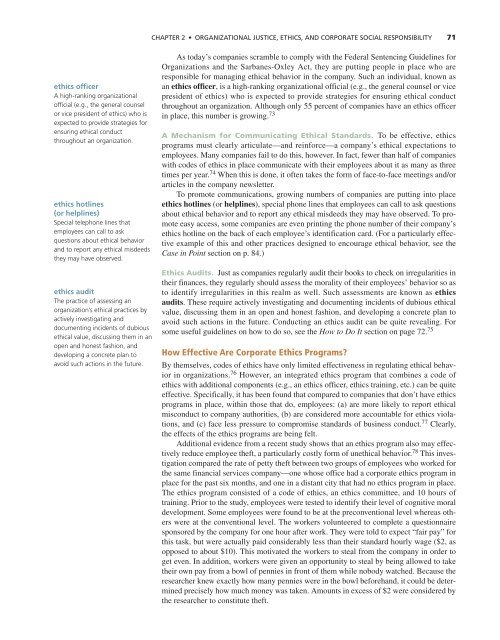Organizational Justice, Ethics, and Corporate Social Responsibility
Organizational Justice, Ethics, and Corporate Social Responsibility
Organizational Justice, Ethics, and Corporate Social Responsibility
Create successful ePaper yourself
Turn your PDF publications into a flip-book with our unique Google optimized e-Paper software.
CHAPTER 2 • ORGANIZATIONAL JUSTICE, ETHICS, AND CORPORATE SOCIAL RESPONSIBILITY 71<br />
ethics officer<br />
A high-ranking organizational<br />
official (e.g., the general counsel<br />
or vice president of ethics) who is<br />
expected to provide strategies for<br />
ensuring ethical conduct<br />
throughout an organization.<br />
ethics hotlines<br />
(or helplines)<br />
Special telephone lines that<br />
employees can call to ask<br />
questions about ethical behavior<br />
<strong>and</strong> to report any ethical misdeeds<br />
they may have observed.<br />
ethics audit<br />
The practice of assessing an<br />
organization’s ethical practices by<br />
actively investigating <strong>and</strong><br />
documenting incidents of dubious<br />
ethical value, discussing them in an<br />
open <strong>and</strong> honest fashion, <strong>and</strong><br />
developing a concrete plan to<br />
avoid such actions in the future.<br />
As today’s companies scramble to comply with the Federal Sentencing Guidelines for<br />
Organizations <strong>and</strong> the Sarbanes-Oxley Act, they are putting people in place who are<br />
responsible for managing ethical behavior in the company. Such an individual, known as<br />
an ethics officer, is a high-ranking organizational official (e.g., the general counsel or vice<br />
president of ethics) who is expected to provide strategies for ensuring ethical conduct<br />
throughout an organization. Although only 55 percent of companies have an ethics officer<br />
in place, this number is growing. 73<br />
A Mechanism for Communicating Ethical St<strong>and</strong>ards. To be effective, ethics<br />
programs must clearly articulate—<strong>and</strong> reinforce—a company’s ethical expectations to<br />
employees. Many companies fail to do this, however. In fact, fewer than half of companies<br />
with codes of ethics in place communicate with their employees about it as many as three<br />
times per year. 74 When this is done, it often takes the form of face-to-face meetings <strong>and</strong>/or<br />
articles in the company newsletter.<br />
To promote communications, growing numbers of companies are putting into place<br />
ethics hotlines (or helplines), special phone lines that employees can call to ask questions<br />
about ethical behavior <strong>and</strong> to report any ethical misdeeds they may have observed. To promote<br />
easy access, some companies are even printing the phone number of their company’s<br />
ethics hotline on the back of each employee’s identification card. (For a particularly effective<br />
example of this <strong>and</strong> other practices designed to encourage ethical behavior, see the<br />
Case in Point section on p. 84.)<br />
<strong>Ethics</strong> Audits. Just as companies regularly audit their books to check on irregularities in<br />
their finances, they regularly should assess the morality of their employees’ behavior so as<br />
to identify irregularities in this realm as well. Such assessments are known as ethics<br />
audits. These require actively investigating <strong>and</strong> documenting incidents of dubious ethical<br />
value, discussing them in an open <strong>and</strong> honest fashion, <strong>and</strong> developing a concrete plan to<br />
avoid such actions in the future. Conducting an ethics audit can be quite revealing. For<br />
some useful guidelines on how to do so, see the How to Do It section on page 72. 75<br />
How Effective Are <strong>Corporate</strong> <strong>Ethics</strong> Programs?<br />
By themselves, codes of ethics have only limited effectiveness in regulating ethical behavior<br />
in organizations. 76 However, an integrated ethics program that combines a code of<br />
ethics with additional components (e.g., an ethics officer, ethics training, etc.) can be quite<br />
effective. Specifically, it has been found that compared to companies that don’t have ethics<br />
programs in place, within those that do, employees: (a) are more likely to report ethical<br />
misconduct to company authorities, (b) are considered more accountable for ethics violations,<br />
<strong>and</strong> (c) face less pressure to compromise st<strong>and</strong>ards of business conduct. 77 Clearly,<br />
the effects of the ethics programs are being felt.<br />
Additional evidence from a recent study shows that an ethics program also may effectively<br />
reduce employee theft, a particularly costly form of unethical behavior. 78 This investigation<br />
compared the rate of petty theft between two groups of employees who worked for<br />
the same financial services company—one whose office had a corporate ethics program in<br />
place for the past six months, <strong>and</strong> one in a distant city that had no ethics program in place.<br />
The ethics program consisted of a code of ethics, an ethics committee, <strong>and</strong> 10 hours of<br />
training. Prior to the study, employees were tested to identify their level of cognitive moral<br />
development. Some employees were found to be at the preconventional level whereas others<br />
were at the conventional level. The workers volunteered to complete a questionnaire<br />
sponsored by the company for one hour after work. They were told to expect “fair pay” for<br />
this task, but were actually paid considerably less than their st<strong>and</strong>ard hourly wage ($2, as<br />
opposed to about $10). This motivated the workers to steal from the company in order to<br />
get even. In addition, workers were given an opportunity to steal by being allowed to take<br />
their own pay from a bowl of pennies in front of them while nobody watched. Because the<br />
researcher knew exactly how many pennies were in the bowl beforeh<strong>and</strong>, it could be determined<br />
precisely how much money was taken. Amounts in excess of $2 were considered by<br />
the researcher to constitute theft.

















